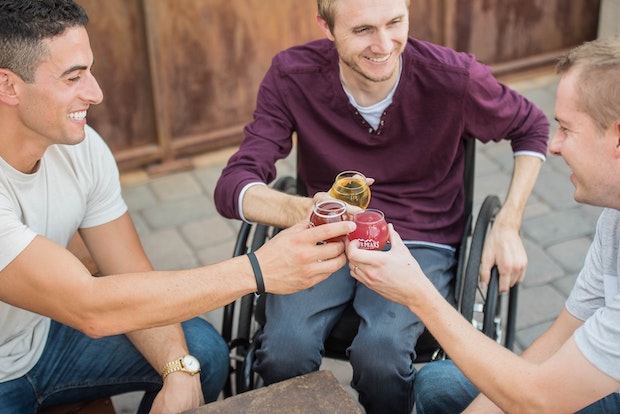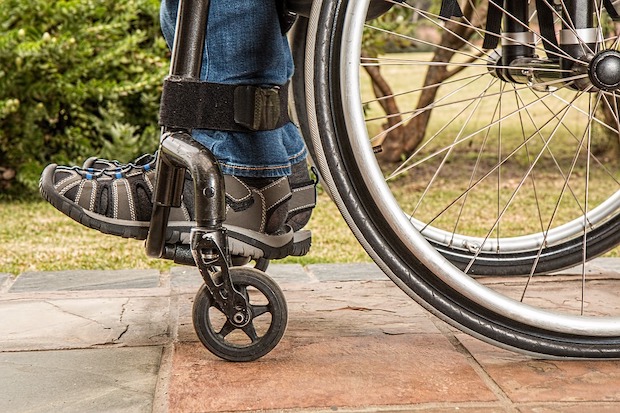
Some media, press and even charities portray disability as inspirational, negative, sad or even tragic. But how do people with disabilities really want to be viewed?
There is no shortage of famous role models with a disability such as Andrea Bocelli, TV news correspondent Frank Gardner, Kylie (a cancer survivor), David Beckham (who has Dyslexia) and Paralympian JJ Chalmers who recently lit up the floor on Strictly.
So why does the media have a long history in using stereotypes to portray people with disabilities - as superheroes, victims or medical miracles. And is it really realistic in 2021 – or is it time for a rethink?

Disability interests me because I have Cerebral Palsy and Epilepsy. I find myself becoming frustrated by the media portrayal of disability that relies on overly-simple stereotypes.
The press portrayal of disability is sometimes met with frustration by non-able bodied people. The phrase “Inspiration Porn,” coined by Australian disability activist Stella Young in 2012, relates to the way that disability is portrayed in the media. Stella used the word ‘porn’ deliberately, because just as in sex porn, Inspiration Porn objectifies or stereotypes one group of people for the satisfaction of another.
Hero
With Inspiration Porn, a disabled person is held up as a hero or inspirational for doing something that a non-disabled person takes for granted. Posters featuring slogans like: “The only disability is a negative attitude,” or “You can achieve anything if you try,” suggest that what holds a disabled person back, is merely their attitude.
Barriers – physical vs invisible
The problem is, despite a person’s positive attitude, it doesn’t change the physical barriers they face. After all, a positive attitude towards going on holiday doesn’t suddenly make the plane wheelchair accessible.
Other examples such as Channel 4’s The Undateables is told from an able-bodied person’s perspective, and demonstrate how the media views disabled people. They are often designed to make a disabled person appear sad and helpless.
They provoke an “awww, isn’t that sweet” reaction or pity from able-bodied viewers. Whilst they’re meant to highlight a disabled person’s achievement, they can be unintentionally patronising and promote the idea that disabled people need the help of non-disabled people to achieve something.
Positive portrayal
The trouble with Inspiration Porn is that it doesn’t promote the positive side of disability, for example, it doesn’t highlight the things the person has achieved, such as their ability to walk, attend mainstream school, university or get a job.
Evolved
Media attitudes to disability have evolved for the better in just a decade, but there remains some way to go. For example, many disabled actors get frustrated when disabled characters are played by able-bodied actors.
Although soaps like Corrie and EastEnders feature disabled characters, which go some way to normalising disabilities, their storylines can be limited to cliched disability issues, rather than reflecting everyday issues including relationships and work.
Civil Service
Talking of work, some civil servants with disabilities or long-term health conditions feel frustrated when colleagues don’t recognise their different needs, or make adjustments that enable them to give their best at work.
Accessibility is about making sure your service can be used by as many people as possible.
Social model of disability
Accessibility stems from the social model of disability which recognises the value that everybody can bring. This contrasts with the traditional Medical Model of Disability which states that a disabled person must be fixed or cured, and if that’s not possible, key decisions about their life will be made by professionals including doctors and care workers.
Inspiration Porn drives the disability rights movements today, but while an individual has an impairment (visible or non-visible), it is society’s attitude that dis-ables a person. This might be reflected through outdated architecture restricting access to buildings or transport.

Latest ONS figures show 53.6 per cent of people with a disability are in employment. However, those in work need to navigate more than transport and lack of ramps. Sometimes it can feel like a marathon just getting to work. Currently, just 11.7 per cent of Civil Servants have self-reported a disability.
Disabled people need more help getting to work. Many local Councils have invested millions introducing often underused cycle lanes. If just a fraction of this was invested in adding ramps to pavements, even the simplest journeys would be transformed for many disabled people.
Avoiding media manipulation?
Although the media can manipulate attitudes to disability, you can combat this, and the way you interact with disabled people is key.
The media portray a disabled person as ‘inspirational’ because they have a job or because they can even get out of bed, even though they're disabled. However, a disabled person really does just want to be accepted in the same light as their able-bodied friends.
Good to talk
The way you act around a disabled person is also important. Don’t be scared to look at disabled people. Don’t be nervous to talk to them. If you’re worried about offending someone, ask them what language and words they don’t like, or think are outdated. If you ask, they won’t be offended.
Once you do that, then it is possible not to look at a disabled person as an inspiration. Instead, you will simply look at them as a normal person just living their life without letting their disability get in the way.

6 comments
Comment by Al Lewis posted on
Broadly agree and support the content of the blog. My only bug bear would be using able-bodied as the opposite to disabled sets it up so those of who's impairments are not physical are not disabled (e.g. those of us with conditions such as Autism, mental health disorders, learning disabilities etc).
It also reinforces the idea that disabled = wheelchair user and only a wheelchair user. When I think that most of us acknowledge that while wheelchair users certainly face disabiling barriers in our society they aren't the only ones who do.
Comment by Christopher Miles posted on
Danny thank you for writing a thought provoking and alternative Blog. That really shows how far we need to go on improving respecting and properly understanding how people with a disability are portrayed in the media etc
Comment by Paul Carter posted on
Danny - thank you for writing this blog. I found it informative and thought-provoking. People can develop a disability at any age so it's important to know how to live with it and talk about it.
Comment by Sarah Bankd posted on
Brilliant blog Darren i hate it when i am seen as someone to be pitied or that I am inspirational. I am me despite by disability and want to be treated the same as able bodied colleagues the adjustments I need are the physical barriers.
Comment by Kenn Palmer posted on
Thank you Darren. Another frustration is the time it's taking to change attitudes within the media. In the 1980s Graeae Theatre Company, Amici Dance Theatre and Candoko Dance challenged the performing arts world and received widespread, positive acclaim for the quality of their work. 40 years later we still have, as you explain, portrayals of disability that are driven by (presumably) viewing figures.
Comment by Ian Goodwin-Reeves posted on
Once the shock value of the term 'Inspirational Porn' wears off the reality of it will sink in. If you then take a look at the Deaf/HoH community the 'hero' aspect takes a possibly unexpected turn with the comment 'oh how cool, sign language, I have always wanted to learn that'.
As a Hearing Sign-student I now ask 'Why is that ?', I have yet to get a reply to the effect of wanting to help or be part of the community, more that it is a novelty or a Y2K version of a Blue Peter Badge. If it infuriates me, I cannot comprehend how a Deaf person views the lightness that their form of communication is viewed.
Personally I just smile, nod at the shallowness, and contemplate the years of training it takes to be fluient in British Sign Language (BSL)